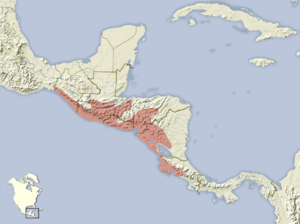Salvin's spiny pocket mouse facts for kids
Quick facts for kids Salvin's spiny pocket mouse |
|
|---|---|
 |
|
| Conservation status | |
| Scientific classification | |
| Genus: |
Heteromys
|
| Species: |
salvini
|
 |
|
| Synonyms | |
|
|
The Salvin's spiny pocket mouse (Heteromys salvini) is a small rodent that lives in Central America and Mexico. It's called a "pocket mouse" because it has special fur-lined pouches in its cheeks, just like pockets! It uses these pockets to carry seeds and other food. This mouse used to be in a different group, but scientists now know it belongs to the Heteromys family.
Contents
What Does It Look Like?
Just like its name suggests, Salvin's spiny pocket mouse has special fur-lined pouches in its cheeks. These are like little backpacks for carrying seeds and other things it finds.
Its fur color can change a bit depending on where it lives. But it's always grey or grey-brown on its back. Its belly, front legs, and feet are a creamy white color. Mixed in with the darker fur on its back are some stiff, spiny hairs and lighter, cream-colored hairs.
The mouse's tail is about the same length as its body. It has two colors and isn't very hairy, though it might have a small tuft of hair at the very end. If you see this mouse where other similar species live, you can tell it apart. It doesn't have orange stripes on its sides, and its front legs aren't dark.
How Big Is It?
- Head and body length: 103–140 mm (about 4 to 5.5 inches)
- Tail length: 97–144 mm (about 3.8 to 5.7 inches)
- Hind foot length: 26–30 mm (about 1 to 1.2 inches)
- Ear length: 12–16 mm (about 0.5 to 0.6 inches)
Where Does It Live?
This pocket mouse lives along much of the Pacific coast of Central America. You can find it from Costa Rica all the way up to Guatemala. It also lives in the very southern part of Mexico. It usually lives in lowlands, but can be found up to 1500 meters (about 4,900 feet) high in the mountains.
What Is Its Home Like?
Salvin's spiny pocket mouse is most common in places with semiarid tropical lowland forests. This means the forests are warm and sometimes dry.
This mouse is a nocturnal animal, which means it is active mostly at night. It can live in many different spots. You might find it underground, in bushes, in trees, among rocks, or under logs. However, it likes brushy, weedy fields the most. These areas offer good hiding places for its burrows. They also protect it from animals that might try to eat it.
What Does It Eat?
While Salvin's spiny pocket mice eat some insects, they mostly love to eat seeds. In Costa Rica, they really like seeds from the buttercup tree during the dry season. At other times of the year, they eat seeds from many different plants. This includes corn, wheat, beans, and even the poisonous seeds of the guanacaste tree.
These mice often aren't full after just one meal. So, they fill their cheek pouches with seeds. They then carry these seeds back to their burrows. They store the seeds there to eat later when food is hard to find. Since they are active at night, they often find seeds by smelling them. Some reports even say they can find seeds buried in animal waste!
Life Cycle and Reproduction
Salvin's spiny pocket mice reproduce for about six months each year, from January to June. Females usually have two litters of babies each year. Each litter has about four baby mice. During this time, the female mice gain a lot of weight.
These mice are a precocial species. This means their babies develop quickly and are quite active soon after birth. Because of this, they have short lives. Most of these mice only live for about one year. A few might live a bit longer, up to 15 to 18 months old. This short lifespan means the population changes very quickly.
How Does It Behave?
This type of pocket mouse is not as social as some other pocket mice. In dry forest areas, the mice have "home ranges" of about 0.20 hectares (about half an acre). These areas can overlap with other mice's ranges. However, mice of the same sex don't get along very well. They can be aggressive towards each other. This often means that the home ranges of female mice are grouped around the home ranges of male mice.
Bigger mice are usually in charge over smaller ones. Adult mice are also in charge over younger mice born that year. Their aggressive behavior doesn't change with the seasons.


